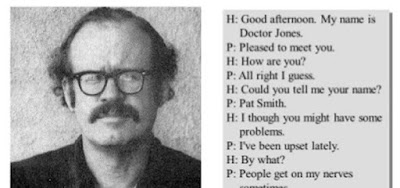Dabbala Rajagopal "Raj" Reddy (1937–) is an Indian American who has made important contributions to artificial intelligence and has won the Turing Award.
He holds the Moza Bint Nasser Chair and University Professor
of Computer Science and Robotics at Carnegie Mellon University's School of
Computer Science.
He worked on the faculties of Stanford and Carnegie Mellon
universities, two of the world's leading colleges for artificial intelligence
research.
In the United States and in India, he has received honors
for his contributions to artificial intelligence.
In 2001, the Indian government bestowed upon him the Padma
Bhushan Award (the third highest civilian honor).
In 1984, he was also given the Legion of Honor, France's
highest honor, which was created in 1802 by Napoleon Bonaparte himself.
In 1958, Reddy obtained his bachelor's degree from the
University of Madras' Guindy Engineering College, and in 1960, he received his
master's degree from the University of New South Wales in Australia.
In 1966, he came to the United States to get his doctorate
in computer science at Stanford University.
He was the first in his family to get a university degree,
which is typical of many rural Indian households.
He went to the academy in 1966 and joined the faculty of
Stanford University as an Assistant Professor of Computer Science, where he
stayed until 1969, after working in the industry as an Applied Science
Representative at IBM Australia from 1960 to 1963.
He began working at Carnegie Mellon as an Associate
Professor of Computer Science in 1969 and will continue to do so until 2020.
He rose up the ranks at Carnegie Mellon, eventually becoming
a full professor in 1973 and a university professor in 1984.
In 1991, he was appointed as the head of the School of
Computer Science, a post he held until 1999.
Many schools and institutions were founded as a result of
Reddy's efforts.
In 1979, he launched the Robotics Institute and served as
its first director, a position he held until 1999.
He was a driving force behind the establishment of the
Language Technologies Institute, the Human Computer Interaction Institute, the
Center for Automated Learning and Discovery (now the Machine Learning
Department), and the Institute for Software Research at CMU during his stint as
dean.
From 1999 to 2001, Reddy was a cochair of the President's
Information Technology Advisory Committee (PITAC).
The President's Council of Advisors on Science and
Technology (PCAST) took over PITAC in 2005.
Reddy was the president of the American Association for
Artificial Intelligence (AAAI) from 1987 to 1989.
The AAAI has been renamed the Association for the
Advancement of Artificial Intelligence, recognizing the worldwide character of
the research community, which began with pioneers like Reddy.
The former logo, acronym (AAAI), and purpose have been
retained.
Artificial intelligence, or the study of giving intelligence
to computers, was the subject of Reddy's research.
He worked on voice control for robots, speech recognition
without relying on the speaker, and unlimited vocabulary dictation, which
allowed for continuous speech dictation.
Reddy and his collaborators have made significant
contributions to computer analysis of natural sceneries, job oriented computer
architectures, universal access to information (a project supported by UNESCO),
and autonomous robotic systems.
Reddy collaborated on Hearsay II, Dragon, Harpy, and Sphinx
I/II with his coworkers.
The blackboard model, one of the fundamental concepts that
sprang from this study, has been extensively implemented in many fields of AI.
Reddy was also interested in employing technology for the
sake of society, and he worked as the Chief Scientist at the Centre Mondial
Informatique et Ressource Humaine in France.
He aided the Indian government in the establishment of the
Rajiv Gandhi University of Knowledge Technologies, which focuses on low-income
rural youth.
He is a member of the International Institute of Information
Technology (IIIT) in Hyderabad's governing council.
IIIT is a non-profit public-private partnership (N-PPP) that
focuses on technological research and applied research.
He was on the board of directors of the Emergency Management
and Research Institute, a nonprofit public-private partnership that offers
public emergency medical services.
EMRI has also aided in the emergency management of its
neighboring nation, Sri Lanka.
In addition, he was a member of the Health Care Management
Research Institute (HMRI).
HMRI provides non-emergency health-care consultation to
rural populations, particularly in Andhra Pradesh, India.
In 1994, Reddy and Edward A. Feigenbaum shared the Turing Award, the top honor in artificial intelligence, and Reddy became the first person of Indian/Asian descent to receive the award.
In 1991, he received the IBM Research Ralph Gomory Fellow
Award, the Okawa Foundation's Okawa Prize in 2004, the Honda Foundation's Honda
Prize in 2005, and the Vannevar Bush Award from the United States National
Science Board in 2006.
Reddy has received fellowships from the Institute of
Electronic and Electrical Engineers (IEEE), the Acoustical Society of America,
and the American Association for Artificial Intelligence, among other
prestigious organizations.
Find Jai on Twitter | LinkedIn | Instagram
You may also want to read more about Artificial Intelligence here.
See also:
Autonomous and Semiautonomous Systems; Natural Language Processing and Speech Understanding.
References & Further Reading:
Reddy, Raj. 1988. “Foundations and Grand Challenges of Artificial Intelligence.” AI Magazine 9, no. 4 (Winter): 9–21.
Reddy, Raj. 1996. “To Dream the Possible Dream.” Communications of the ACM 39, no. 5 (May): 105–12.










